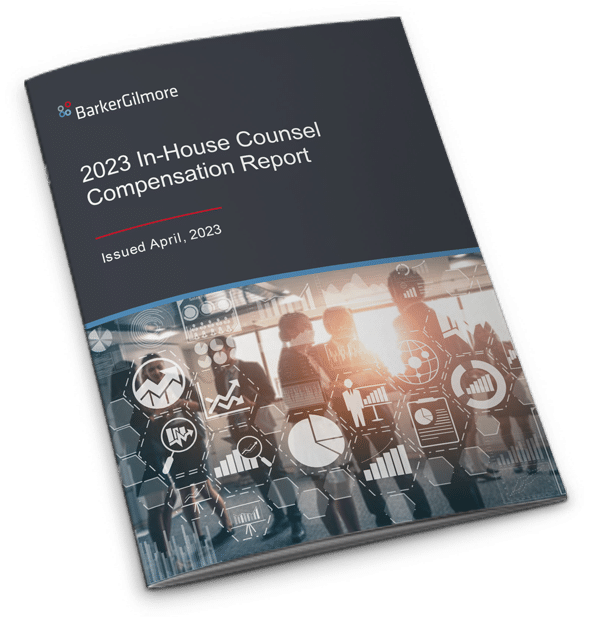Within the last year, uncovering compensation information has become increasingly difficult as states and cities across the country began passing legislation that bans employers from questioning potential hires on salary history. States like California and Massachusetts have already approved the legislation, along with New York City, Philadelphia, and other major cities. The purpose of these new restrictions is to eliminate the gender pay gap existing in the U.S. today. This year’s compensation data indicates that in-house counsel experience this disparity, with female in-house counsel earning about 84% of their male counterparts. While the percentage varies slightly by position level, the overall size of the disparity lines up closely with national averages.
Though compensation inquiry regulations present a viable effort to reduce wage discrimination, it has become more difficult for in-house teams to create compelling compensation packages for candidates. Human Resources teams have historically vetted the current compensation of potential hires to, at the very least, construct an employment offer attractive enough to close the candidate. Without the capability to do so, closing the finalist candidate has become riskier and much less certain.
The 2018 In-House Counsel Compensation Report attempts to help bridge this newfound barrier to communication by providing employers and candidates alike with an industry benchmark to consider while negotiating the final offer. Among many interesting data points and correlations, we isolate these six trends below as the most prominent for 2018:
- Annual Salary Increase Rates: The median annual salary increase rate for all positions across industries dipped to 3.8%, down 0.5% from the previous year, with the life sciences sector experiencing the highest median increase rate of 5.2% from 2016 to 2017.Financial, Energy, and Industrial and Manufacturing industries experienced base increases in line with the previous year, while Consumer, Healthcare, Technology and Professional services saw smaller increases overall.
- Peer Comparison: 41% of all respondents believe their compensation is below or significantly below that of their peers in other organizations, with labor and employment lawyers and litigators reporting the greatest dissatisfaction. Those in the energy and banking/finance practice areas express the highest levels of satisfaction with over 24% reporting compensation above or significantly above average.
- Who’s on the Market: 41% of respondents indicate that they would consider a new position within the next year due to compensation issues. Those in the consumer industry report the greatest likelihood of a job search in the next year, while those in the energy industry are the least likely to engage in a job search. This trend is particularly interesting, because last years’ report showed energy industry counsel as the most likely to engage in a job search. This year, in-house counsel with practice area concentrations in intellectual property, labor and employment, and litigation are most likely to consider a move for compensation issues, while those who identify with a generalist practice area report least likely to move.
- Public vs. Private: At the General Counsel level, a statistically significant difference exists between the compensation of those at publicly-traded companies and those at private companies. The size of this gap decreases as position level decreases; smaller disparities exist at the Managing Counsel and Senior Counsel levels. The Long-Term Incentive (LTI) compensation component poses the greatest disparity across all position levels; LTI is much higher for public-company employees and sometimes non-existent for private-company employees. A gap in LTI between General Counsel and lower level in-house counsel within public organizations accounts for the larger pay gap between GCs and the other law department lawyers than in private companies.
- Gender Pay Trends: On average, female in-house counsel earn 84% of what male in-house counsel earn. The gap is much larger at the General Counsel level, with a 78% disparity, than at Managing Counsel or Senior Counsel levels, which show 90% and 89% disparities, respectively. Despite the disparity in total compensation, in 2018, female in-house counsel experienced a base pay increase equivalent to that of male in-house counsel, 3.8%.
- Industry Highs and Lows: While the lowest paying industries were consistent across the board this year, there were significant changes in the highest paying industries form the previous year:
| Position | Public | Private |
| Highest Paying | ||
| General Counsel | Industrial & Manufacturing | Financial |
| Managing Counsel | Energy | Financial |
| Senior Counsel | Life Sciences | Energy |
| Lowest Paying | ||
| General Counsel | Professional Services | Professional Services |
| Managing Counsel | Professional Services | Healthcare |
| Senior Counsel | Professional Services | Professional Services |
In addition to the six key trends above, the 2018 report features a detailed breakdown of specific compensation figures for General Counsel, Managing Counsel, and Senior Counsel. Download your free copy of the 2018 In-House Counsel Compensation Report for access to highly valuable benchmarking data today!
Connect with a legal recruiting advisor
* indicates required fields







